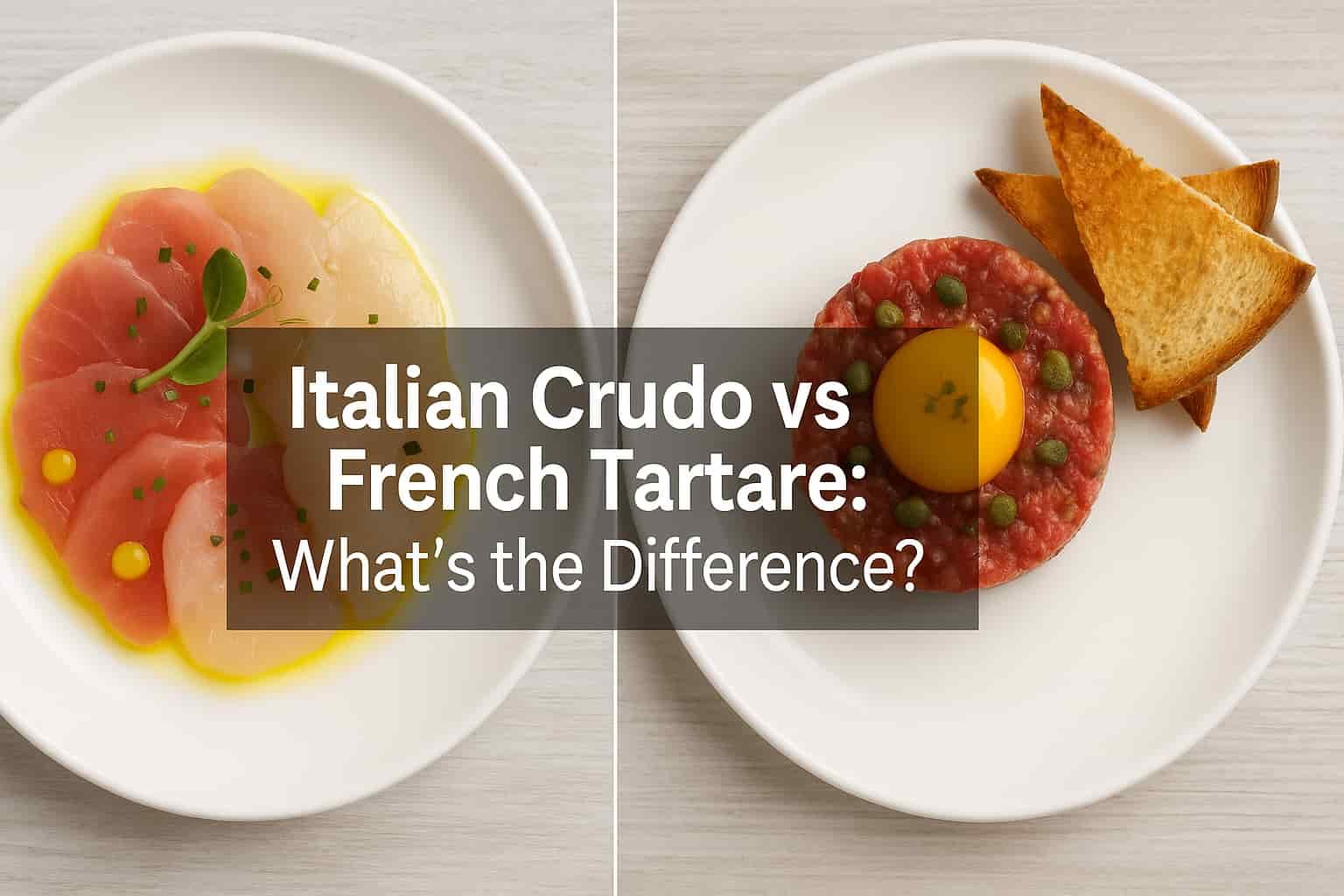Raw dishes like Italian Crudo and French Tartare represent two of Europe’s most refined culinary traditions. Though they both celebrate raw proteins, their preparation methods, ingredients, cultural contexts, and serving styles differ significantly. Crudo emphasizes simplicity, freshness, and light seasoning, while Tartare incorporates robust condiments, finely minced proteins, and structured plating. Understanding the exact differences between these two raw preparations is essential for chefs, diners, and food writers who value authenticity and precision in culinary terminology.
This article offers a factual, detailed breakdown of Crudo and Tartare by answering the most common questions asked by curious diners and culinary professionals. By the end, you’ll know precisely what sets them apart in taste, preparation, presentation, and nutrition.
Contents
- 1 What is Italian Crudo and how is it traditionally prepared?
- 2 What is French Tartare and how is it traditionally prepared?
- 3 How do the preparation techniques of Crudo and Tartare differ?
- 4 What is the historical origin of Crudo and Tartare?
- 5 How do presentation styles vary between Crudo and Tartare?
- 6 Which wines and sides are best paired with Crudo vs. Tartare?
- 7 Which dish is healthier: Crudo or Tartare?
- 8 Where can you find the best Crudo and Tartare in upscale restaurants?
- 9 What should diners consider when ordering Crudo or Tartare?
- 10 What are the key differences between Crudo and Tartare at a glance?
What is Italian Crudo and how is it traditionally prepared?
Italian Crudo is a raw dish made from thinly sliced seafood or meat, dressed with high-quality oils, citrus, and minimal garnish.
Unlike ceviche, Crudo is not marinated or cured. It is assembled and served immediately to preserve the natural texture of the protein. The focus is on highlighting ingredient quality rather than transformation through seasoning.
What types of seafood or meat are typically used in Crudo?
Crudo traditionally features raw seafood such as scallops, tuna, branzino, or langoustine.
In coastal regions of Italy, chefs frequently use Mediterranean fish like orata and red mullet. In some modern adaptations, raw beef or veal is used, although seafood remains the dominant choice in traditional Crudo.
One notable example is scallop Crudo, where the delicate sweetness of the scallop is highlighted by minimal seasoning. Learn more in Raw Scallops in Italian Crudo: A Culinary Staple.
What are the key ingredients in the seasoning and garnish?
The primary seasonings for Crudo include extra virgin olive oil, sea salt, lemon juice, and occasionally chili or herbs.
No sauces, dressings, or heavy marinades are used. Instead, Crudo relies on ingredient purity. Chefs may add microgreens, edible flowers, or crushed nuts to enhance visual appeal without overpowering the core flavors.
How is the texture and flavor profile of Crudo described?
Crudo has a delicate, buttery texture with bright, clean flavors.
Because the proteins are sliced, not minced, they retain a soft and silky mouthfeel. The balance of citrus acidity and olive oil fat brings out the subtle sweetness of raw seafood, especially scallops and sea bream.
What is French Tartare and how is it traditionally prepared?
French Tartare is a dish of finely chopped or minced raw protein mixed with seasonings and condiments, usually served with bread or fries.
Tartare is fully mixed before serving, creating a cohesive blend of textures and flavors. The dish is typically assembled tableside in fine dining settings to ensure freshness.
What proteins are commonly used in Tartare dishes?
Tartare is most commonly made from beef, followed by tuna, salmon, and occasionally duck or lamb.
In classic French cuisine, steak tartare is the default unless otherwise specified. Tuna Tartare has become more common in contemporary fusion menus, especially in international restaurants.
What role do spices, herbs, and condiments play in Tartare?
Condiments like Dijon mustard, Worcestershire sauce, capers, shallots, and egg yolk are integral to Tartare preparation.
These elements are not optional—they define the flavor profile of the dish. Parsley, chives, and black pepper are frequently added to balance the richness of raw meat or fish.
How is the consistency and taste of Tartare usually perceived?
Tartare has a dense, creamy consistency with bold, savory flavors.
The texture comes from mincing the protein rather than slicing. Its flavor is more pungent and intense than Crudo due to the use of acidic and fermented ingredients like mustard and vinegar.
How do the preparation techniques of Crudo and Tartare differ?
Crudo is sliced and dressed just before serving, while Tartare is chopped and fully mixed with seasonings before plating.
The difference in technique leads to distinct textures, flavor distribution, and visual presentation.
Is there any cooking or curing involved in either dish?
Neither Crudo nor Tartare involves heat-based cooking, but Tartare includes stronger acidic and fermented agents that alter the protein slightly.
Crudo is as close to raw as possible, preserving full moisture and structure. Tartare’s ingredients partially denature proteins, resulting in a firmer bite and tangy taste.
How is knife technique important in each preparation method?
Crudo requires precise slicing, while Tartare demands even mincing.
For Crudo, fish must be cut along the grain with a single motion to avoid bruising the flesh. Tartare involves dicing the protein uniformly to ensure even distribution of flavor and texture.
Are the ingredients pre-marinated or seasoned on the plate?
In Crudo, seasoning is applied directly on the plate; in Tartare, it is fully integrated into the mix before serving.
Crudo is plated like sashimi with dressing applied afterward. Tartare is tossed in a mixing bowl with all components and then shaped, usually with a ring mold, before serving.
What is the historical origin of Crudo and Tartare?
Crudo originates from southern Italian coastal regions, while Tartare evolved in early 20th-century France.
The two dishes emerged independently, influenced by different culinary traditions, ingredient availability, and cultural preferences for raw food.
When and where did Italian Crudo become a staple dish?
Crudo developed in regions like Puglia, Sicily, and Liguria where fishermen consumed raw catch directly at sea.
The tradition dates back to at least the 19th century, when fishermen dressed raw fish with local olive oil and citrus. The dish remained regional until Italian fine dining began incorporating Crudo into formal menus in the 1980s.
What are the French culinary roots of Tartare?
Tartare was first formalized as steak à l’américaine in French brasseries during the early 1900s.
The modern steak tartare originated in Paris, popularized by Auguste Escoffier. It evolved from dishes inspired by German and Russian raw meat preparations but was refined with distinctly French seasoning and tableside service.
Have global influences shaped these dishes in modern cuisine?
Modern Crudo has absorbed Japanese minimalism, while Tartare has adopted global flavors like wasabi and yuzu.
Crudo often borrows plating techniques and soy-based dressings from Japanese sashimi. Tartare now includes variations like Korean beef Yukhoe and even vegan mushroom versions in plant-based restaurants.
How do presentation styles vary between Crudo and Tartare?
Crudo is plated flat with delicate garnishes, while Tartare is molded vertically with structured toppings.
The visual distinction between the two is immediate. Crudo embraces asymmetry and lightness; Tartare prioritizes shape and density.
What plateware and garnish are typically used in each?
Crudo is served on chilled flat plates or shallow bowls, decorated with herbs, citrus zest, or edible flowers.
Minimalism guides Crudo plating. Chefs avoid clutter, ensuring the eye focuses on color contrast and freshness.
Tartare is often molded using a ring, then topped with quail egg yolk, microgreens, or shaved truffles.
The plate may include toasted bread, pickled vegetables, or dots of aioli around the structure to complete the dish visually and texturally.
How do chefs use plating to highlight freshness and artistry?
Chefs highlight Crudo’s freshness by spacing slices and layering translucent flesh with reflective oils and citrus beads.
The translucency and sheen of the protein communicate freshness without needing to say a word.
In Tartare, chefs emphasize density, balance, and garnish symmetry to showcase precision and richness.
The visual weight of the dish matches its flavor intensity, often with architectural plating and circular design.
Which wines and sides are best paired with Crudo vs. Tartare?
Crudo pairs with light, crisp white wines, while Tartare matches well with bold reds or structured whites.
Pairings depend on protein type and seasoning strength, but the general rule is to complement, not overpower, the raw flavors.
What wines complement the delicate flavors of Crudo?
Crudo pairs well with dry whites like Vermentino, Pinot Grigio, and Chablis.
These wines have high acidity, low oak influence, and minerality that enhance the seafood’s natural sweetness. Sparkling wines like Franciacorta or Champagne also complement Crudo due to their cleansing bubbles.
Which pairings enhance the richness of Tartare?
Beef Tartare is best with medium-bodied reds like Beaujolais, Pinot Noir, or Barbera.
These wines balance acidity and fruit to cut through the fat without overwhelming the palate. For tuna or salmon Tartare, dry Rieslings and Grüner Veltliner offer structure and citrus lift.
Are there specific bread, pickles, or greens that go well with each?
Crudo is served with neutral sides like crostini, fennel salad, or cucumber ribbons.
These elements provide texture and temperature contrast without interfering with the protein.
Tartare often includes toasted sourdough, cornichons, or mustard greens.
Each side complements the dish’s intensity and provides functional scooping or palate-resetting roles.
Which dish is healthier: Crudo or Tartare?
Crudo is generally lighter and lower in calories than Tartare due to its minimal seasoning and absence of emulsified condiments.
Nutritional comparisons between the two must consider portion size, protein source, and seasoning ingredients. While both are raw dishes, their nutritional impact is not equal.
How do they compare in calories, fat, and sodium?
A 100g serving of Crudo made with scallops contains approximately 90 calories, 1g of fat, and 180mg of sodium.
The low fat content comes from lean seafood and olive oil drizzle. Sodium remains low unless additional salt is added tableside.
A 100g serving of steak Tartare with egg yolk and mustard contains around 180 calories, 12g of fat, and 350mg of sodium.
The fat content increases due to beef and yolk. Sodium spikes with capers, Worcestershire sauce, and Dijon mustard.
What are the microbiological risks and how are they managed?
Both dishes carry risk of bacterial contamination, but Crudo has a higher risk of parasitic infection if seafood is not frozen properly.
Anisakis, a marine parasite, must be neutralized through freezing at −20°C for at least 24 hours. For Tartare, pathogens like E. coli and Listeria are the primary concerns, mitigated by using high-grade beef and strict refrigeration.
Do dietary restrictions influence one choice over the other?
Crudo is preferred by pescatarians and those following Mediterranean or low-fat diets.
Its lightness fits into anti-inflammatory and heart-conscious eating patterns.
Tartare aligns with high-protein, keto, or carnivore diets, but is unsuitable for individuals avoiding red meat or egg yolk.
The richness and seasoning also pose challenges for those on low-sodium or low-fat regimens.
Where can you find the best Crudo and Tartare in upscale restaurants?
Top-tier Crudo is commonly served in coastal Italian or Michelin-starred seafood restaurants, while elite Tartare is a staple of French brasseries and modern bistros.
Global fine dining scenes offer regional excellence in both categories.
Which cities or restaurants are known for authentic Crudo?
Cities like Milan, Rome, and Amalfi are renowned for Crudo, with restaurants such as Langosteria, Il Sanlorenzo, and Da Vincenzo setting benchmarks.
These venues emphasize pristine sourcing, daily fish deliveries, and minimalist plating, often using olive oil pressed within 48 hours.
Where is French Tartare served at its best?
Paris, Lyon, and Bordeaux host iconic Tartare dishes at establishments like Le Severo, Bistrot Paul Bert, and Le Comptoir du Relais.
In these settings, Tartare is often hand-chopped à la minute and paired with heritage wines, ensuring traditional authenticity.
Are there fusion or modern reinterpretations worth trying?
Crudo is often reimagined with Japanese touches like yuzu kosho or shiso, especially in restaurants like Nobu and Zuma.
Tartare has expanded into duck, beetroot, and even tofu variations in Michelin-starred tasting menus such as those at Eleven Madison Park or Septime.
What should diners consider when ordering Crudo or Tartare?
Diners should evaluate ingredient freshness, hygiene standards, and plating transparency before ordering any raw dish.
Knowing how to read the menu and engage the server empowers a safer and more enjoyable dining experience.
How can you assess the freshness and quality of raw dishes?
Crudo should display a translucent appearance, no fishy odor, and clean edges.
Cloudiness, soggy texture, or uneven coloring signals poor handling or aging.
Tartare must have a vivid color, cohesive shape, and no excess liquid pooling around the meat.
Oxidation or excess moisture indicates improper mincing or over-resting before plating.
Are there etiquette tips when eating raw dishes in fine dining?
Use cutlery gently to avoid disrupting presentation, and eat each bite fully to experience the balance of flavors.
Avoid adding table salt or sauces unless offered by the chef as part of the dish.
What questions can you ask your server about raw preparations?
Ask about the source of the protein, date of delivery, freezing protocols (for seafood), and whether the dish is prepared to order.
What are the key differences between Crudo and Tartare at a glance?
Crudo emphasizes simplicity, clean flavors, and sliced seafood, while Tartare focuses on bold seasoning, minced protein, and integrated textures.
Each dish has a distinct identity, rooted in geography, culinary philosophy, and ingredient handling.
| Feature | Italian Crudo | French Tartare |
|---|---|---|
| Primary Protein | Seafood (tuna, scallops, branzino) | Beef, tuna, salmon |
| Preparation Method | Thin slicing, dressed on plate | Finely chopped and pre-mixed |
| Seasonings | Olive oil, citrus, sea salt | Mustard, capers, shallots, yolk |
| Presentation Style | Flat, minimalist plating | Molded into tower or mound |
| Calories per 100g | ~90 kcal (scallop Crudo) | ~180 kcal (beef Tartare) |
| Origin | Southern Italy (19th century) | France (early 20th century) |
| Pairing Wines | Vermentino, Pinot Grigio, Franciacorta | Beaujolais, Riesling, Pinot Noir |
| Texture | Delicate, silky | Dense, creamy |
| Culinary Philosophy | Highlight ingredient purity | Emphasize richness and complexity |
Crudo is ideal when seeking light, refreshing raw seafood with a clean finish. Tartare is preferred for deeper flavor layers and textural richness.
Choosing between the two depends on your taste preference, dietary goals, and context—whether you’re dining seaside on the Amalfi coast or inside a Parisian bistro.



